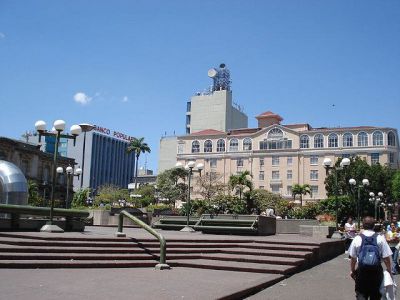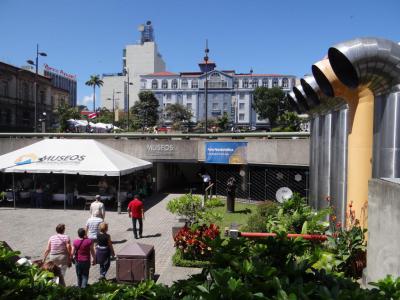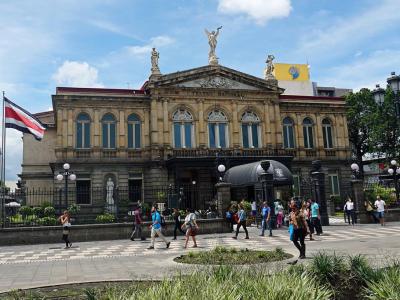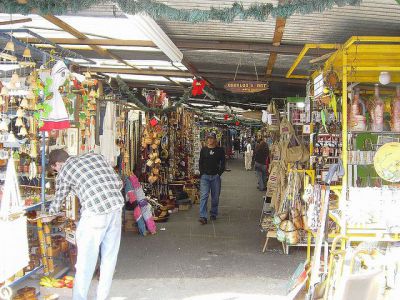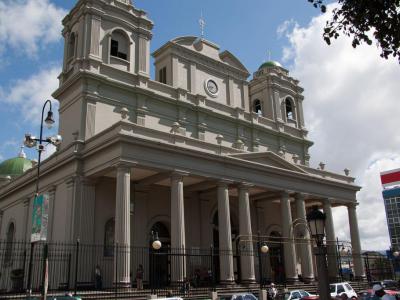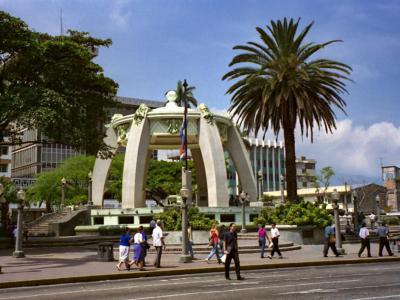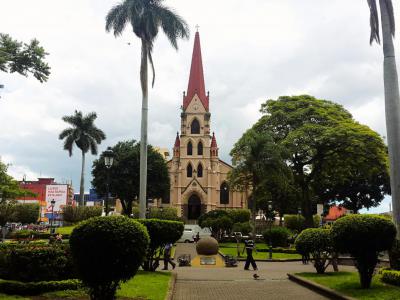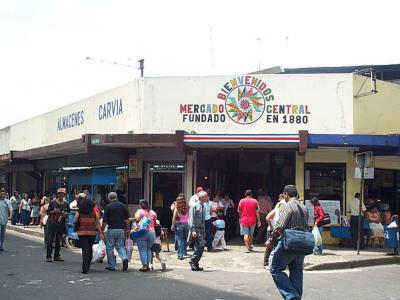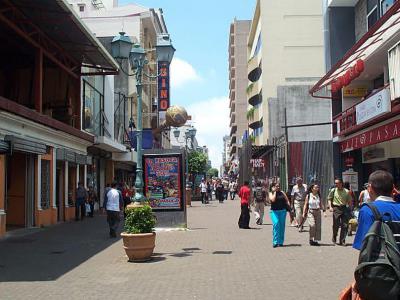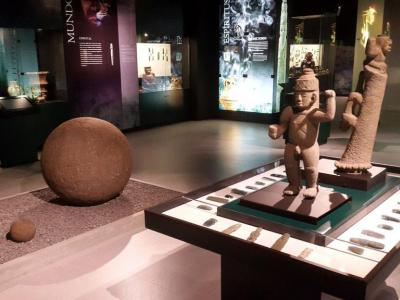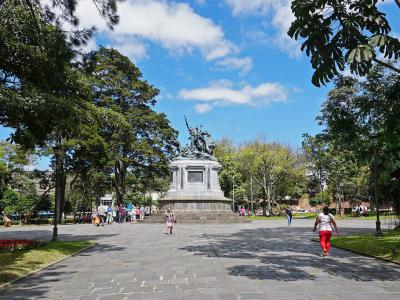Audio Guide: San Jose Introduction Walking Tour (Self Guided), San Jose
Ricardo Jimenez Oreamuno, former president of Costa Rica, once said: “San Jose is the heart of Costa Rica, where the pulse of the nation beats.”
San Jose, Costa Rica's capital, has a rich history dating back to the early 19th century. The city's origins are tied to the country’s shift toward independence and urban development. Before becoming the capital, Costa Rica’s main administrative center was Cartago. However, after gaining independence from Spain in 1821, the government sought a more strategically located and accessible center. In 1823, San José was officially designated the capital of Costa Rica, thanks to its favorable geography in the Central Valley, surrounded by mountains and located near the country’s most important trade routes.
The name "San Jose" was chosen in honor of Saint Joseph, the patron saint of workers. At the time, the town was relatively small, with a population of only about 1,500 people. The city's growth accelerated when it became the administrative heart of the newly independent nation. Its population expanded as railways and roads were constructed, facilitating trade and movement. By the mid-1800s, San Jose was rapidly developing, with a booming economy based on agriculture, coffee exports, and later, textiles.
In the late 19th and early 20th centuries, San Jose underwent significant transformations. European influences, especially from the Spanish and French, are evident in the city’s architecture, from grand neoclassical buildings to beautiful parks and public spaces. During this period, San Jose became a cultural hub, home to museums, theaters, and the establishment of Costa Rica’s first public university.
Walking through downtown San Jose, you will encounter a vibrant mix of historic and modern architecture, including the grand National Theater and the neoclassical Culture Square. The lively Central Market offers local food and crafts, while the Pre-Columbian Gold Museum highlights Costa Rica's rich history. Parks like Central Park provide green spaces, and the bustling streets are filled with cafes, shops, and street vendors, offering a true taste of local life.
As you explore the streets of this dynamic city, you’ll feel the pulse of the nation that Jiménez Oreamuno so aptly described. Every corner of San José reveals a piece of Costa Rica’s soul—its culture, history, and ever-present energy. Follow this self-guided walking tour, and let your journey through the heart of the country begin.
San Jose, Costa Rica's capital, has a rich history dating back to the early 19th century. The city's origins are tied to the country’s shift toward independence and urban development. Before becoming the capital, Costa Rica’s main administrative center was Cartago. However, after gaining independence from Spain in 1821, the government sought a more strategically located and accessible center. In 1823, San José was officially designated the capital of Costa Rica, thanks to its favorable geography in the Central Valley, surrounded by mountains and located near the country’s most important trade routes.
The name "San Jose" was chosen in honor of Saint Joseph, the patron saint of workers. At the time, the town was relatively small, with a population of only about 1,500 people. The city's growth accelerated when it became the administrative heart of the newly independent nation. Its population expanded as railways and roads were constructed, facilitating trade and movement. By the mid-1800s, San Jose was rapidly developing, with a booming economy based on agriculture, coffee exports, and later, textiles.
In the late 19th and early 20th centuries, San Jose underwent significant transformations. European influences, especially from the Spanish and French, are evident in the city’s architecture, from grand neoclassical buildings to beautiful parks and public spaces. During this period, San Jose became a cultural hub, home to museums, theaters, and the establishment of Costa Rica’s first public university.
Walking through downtown San Jose, you will encounter a vibrant mix of historic and modern architecture, including the grand National Theater and the neoclassical Culture Square. The lively Central Market offers local food and crafts, while the Pre-Columbian Gold Museum highlights Costa Rica's rich history. Parks like Central Park provide green spaces, and the bustling streets are filled with cafes, shops, and street vendors, offering a true taste of local life.
As you explore the streets of this dynamic city, you’ll feel the pulse of the nation that Jiménez Oreamuno so aptly described. Every corner of San José reveals a piece of Costa Rica’s soul—its culture, history, and ever-present energy. Follow this self-guided walking tour, and let your journey through the heart of the country begin.
How it works: Download the app "GPSmyCity: Walks in 1K+ Cities" from Apple App Store or Google Play Store to your mobile phone or tablet. The app turns your mobile device into a personal tour guide and its built-in GPS navigation functions guide you from one tour stop to next. The app works offline, so no data plan is needed when traveling abroad.
San Jose Introduction Walking Tour Map
Guide Name: San Jose Introduction Walking Tour
Guide Location: Costa Rica » San Jose (See other walking tours in San Jose)
Guide Type: Self-guided Walking Tour (Sightseeing)
# of Attractions: 11
Tour Duration: 2 Hour(s)
Travel Distance: 3.2 Km or 2 Miles
Author: john
Sight(s) Featured in This Guide:
Guide Location: Costa Rica » San Jose (See other walking tours in San Jose)
Guide Type: Self-guided Walking Tour (Sightseeing)
# of Attractions: 11
Tour Duration: 2 Hour(s)
Travel Distance: 3.2 Km or 2 Miles
Author: john
Sight(s) Featured in This Guide:
- Plaza de la Cultura (Culture Square)
- Museo del Oro Precolombino (Pre-Columbian Gold Museum)
- Teatro Nacional (National Theater)
- Mercado Municipal de Artesania (Municipal Market of Handcrafts)
- Catedral Metropolitana (Metropolitan Cathedral )
- Central Park
- Iglesia de la Merced (Church of Our Lady of La Merced)
- Mercado Central (Central Market)
- Avenida Central (Central Avenue)
- Museo del Jade (Jade Museum)
- Parque Nacional (National Park)
1) Plaza de la Cultura (Culture Square)
Right in the heart of San José, Culture Square is where the city comes alive. Set along the Central Avenue Pedestrian Mall, it’s the perfect spot to people-watch, toss a few crumbs to the ever-hungry pigeons, or catch an impromptu street performance.
Take a leisurely stroll around the square or relax under a shady tree—there’s always a bench waiting for you. When hunger strikes, cafés, shops, and restaurants are just steps away, offering everything from Costa Rican coffee to local treats.
Built between 1977 and 1982, the square transformed what was once a neglected park into a lively public gathering place, thanks to architects Jorge Bertheau, Jorge Borbón, and Edgar Vargas. And don’t miss what lies beneath your feet—the Pre-Colombian Gold Museum, completed in 1985. Home to over 4,000 glittering artifacts, it’s a treasure trove of Costa Rica’s ancient history, hidden just below the city’s modern pulse.
Take a leisurely stroll around the square or relax under a shady tree—there’s always a bench waiting for you. When hunger strikes, cafés, shops, and restaurants are just steps away, offering everything from Costa Rican coffee to local treats.
Built between 1977 and 1982, the square transformed what was once a neglected park into a lively public gathering place, thanks to architects Jorge Bertheau, Jorge Borbón, and Edgar Vargas. And don’t miss what lies beneath your feet—the Pre-Colombian Gold Museum, completed in 1985. Home to over 4,000 glittering artifacts, it’s a treasure trove of Costa Rica’s ancient history, hidden just below the city’s modern pulse.
2) Museo del Oro Precolombino (Pre-Columbian Gold Museum) (must see)
Hidden beneath Culture Square in downtown San José, the Pre-Columbian Gold Museum sparkles as one of Costa Rica’s true underground treasures. Managed by the Central Bank of Costa Rica, this fascinating space houses more than 1,600 gold artifacts dating back to 500 AD, each one gleaming with stories of artistry, power, and ancient prestige.
The exhibits range from delicate amulets, earrings, and animal figurines—especially frogs, symbols of fertility and transformation—to a few bold erotic statuettes. The highlight is The Warrior, a life-sized gold figure magnificently adorned with ornaments and displayed in a glass case, embodying the splendor of Costa Rica’s pre-Columbian heritage.
A replica of a pre-Columbian grave, discovered on a banana plantation in the 1950s, adds a touch of archaeological drama. Filled with 88 gold objects, it captures the ritual and reverence of a long-vanished world.
Just above, the National Coin Museum continues the journey through time, tracing the evolution of currency from 1236 AD to the present. Its displays feature everything from the nation’s first coin, the Media Escudo of 1825, to coffee tokens and rare banknotes. Highlights also include the early coins of the Mexican Mint, founded in 1535—the first in the Americas—whose silver eight-real pieces and pesos became the ancestors of modern currencies, including the U.S. Dollar.
Though modest in size, the museum offers an impressive window into Costa Rica’s economic history. Blending glittering craftsmanship with cultural insight, it remains one of San José’s most captivating and distinctive attractions.
The exhibits range from delicate amulets, earrings, and animal figurines—especially frogs, symbols of fertility and transformation—to a few bold erotic statuettes. The highlight is The Warrior, a life-sized gold figure magnificently adorned with ornaments and displayed in a glass case, embodying the splendor of Costa Rica’s pre-Columbian heritage.
A replica of a pre-Columbian grave, discovered on a banana plantation in the 1950s, adds a touch of archaeological drama. Filled with 88 gold objects, it captures the ritual and reverence of a long-vanished world.
Just above, the National Coin Museum continues the journey through time, tracing the evolution of currency from 1236 AD to the present. Its displays feature everything from the nation’s first coin, the Media Escudo of 1825, to coffee tokens and rare banknotes. Highlights also include the early coins of the Mexican Mint, founded in 1535—the first in the Americas—whose silver eight-real pieces and pesos became the ancestors of modern currencies, including the U.S. Dollar.
Though modest in size, the museum offers an impressive window into Costa Rica’s economic history. Blending glittering craftsmanship with cultural insight, it remains one of San José’s most captivating and distinctive attractions.
3) Teatro Nacional (National Theater) (must see)
The National Theater of Costa Rica stands as one of San José’s crown jewels, a monument to the city’s golden age of coffee wealth and cultural ambition. Construction began in 1891, and by 1897 the curtain rose on Goethe’s Faust, inaugurating what would become a symbol of national pride. Its creation was fueled, quite literally, by coffee — when export profits soared, a tax on the trade helped finance this grand temple of the arts.
Inside, the theater impresses with marble staircases, gilded ceilings, and ornate furnishings that would feel at home in Paris or Vienna. Every inch of its interior whispers of a time when San José dreamed big and refused to settle for provincial charm. The blend of European opulence and Costa Rican craftsmanship creates a stage that’s as captivating as any performance held there.
Outside, the statues of playwright Calderón de la Barca and composer Ludwig van Beethoven stand watch at the entrance, immortalized not only in bronze but also on the country’s currency. Today, the theater remains an active venue, hosting regular performances that keep its grand spirit alive — proof that art, like coffee, continues to be one of Costa Rica’s finest exports.
Tip:
If you have a ticket for a performance, ask for the free English tour included in the ticket price to learn a bit of history about the place.
Inside, the theater impresses with marble staircases, gilded ceilings, and ornate furnishings that would feel at home in Paris or Vienna. Every inch of its interior whispers of a time when San José dreamed big and refused to settle for provincial charm. The blend of European opulence and Costa Rican craftsmanship creates a stage that’s as captivating as any performance held there.
Outside, the statues of playwright Calderón de la Barca and composer Ludwig van Beethoven stand watch at the entrance, immortalized not only in bronze but also on the country’s currency. Today, the theater remains an active venue, hosting regular performances that keep its grand spirit alive — proof that art, like coffee, continues to be one of Costa Rica’s finest exports.
Tip:
If you have a ticket for a performance, ask for the free English tour included in the ticket price to learn a bit of history about the place.
4) Mercado Municipal de Artesania (Municipal Market of Handcrafts) (must see)
The Municipal Craft Market in San José is a lively open-air hub where the city’s rich artisan traditions come to life. Colorful stalls brim with handcrafted jewelry, wood carvings, baskets, pottery, t-shirts, and decorative art, many of which can be admired while watching skilled artisans at work.
Unlike other markets in the city, the focus here leans strongly toward authentic handcrafts rather than mass-produced souvenirs, offering a more genuine glimpse into Costa Rican creativity. With room for 88 vendors and plenty of space to stroll, the market invites leisurely exploration amid its vibrant displays and tempting wares.
Beyond shopping, the atmosphere is part of the charm: the bustling stalls, the scent of local foods, and the occasional performance or demonstration create a dynamic, sensory experience that captures the essence of San José’s cultural heart.
Unlike other markets in the city, the focus here leans strongly toward authentic handcrafts rather than mass-produced souvenirs, offering a more genuine glimpse into Costa Rican creativity. With room for 88 vendors and plenty of space to stroll, the market invites leisurely exploration amid its vibrant displays and tempting wares.
Beyond shopping, the atmosphere is part of the charm: the bustling stalls, the scent of local foods, and the occasional performance or demonstration create a dynamic, sensory experience that captures the essence of San José’s cultural heart.
5) Catedral Metropolitana (Metropolitan Cathedral ) (must see)
The Metropolitan Cathedral of San José, originally constructed in 1802, has long served as the spiritual heart of the city’s Catholic community. The early church, however, did not escape the region’s seismic activity—an earthquake in the early 1800s left the building damaged, prompting a major reconstruction in 1871.
The cathedral’s current design is a unique blend of Greek Orthodox, Neo-Classical, and Baroque styles, reflecting both European influence and local craftsmanship. Doric pilasters, a neo-classical pediment, and side steeples elegantly combine to honor the church’s historical origins while presenting a grand façade to the city.
Inside, the cathedral continues to impress with its finely tiled Colonial floors and beautifully crafted stained-glass windows, each depicting vivid biblical stories. Intricate wooden cherubs hover near the altar, where a carefully carved figure of Christ commands attention.
Beyond the artistic beauty, the cathedral is steeped in historical significance. In 1983, Pope John Paul II visited San José, leaving a lasting mark with a marble statue that now stands in the north garden, commemorating his presence. The cathedral’s crypt also holds historical treasures: the remains of two former archbishops and a Costa Rican president rest here, connecting the church not only to spiritual life but also to the nation’s political and cultural heritage.
Tip:
Although not technically part of the cathedral complex, a small statue of Holocaust victim Anne Frank graces the pedestrian mall on the building's south side. It was donated by the Embassy of the Netherlands.
The cathedral’s current design is a unique blend of Greek Orthodox, Neo-Classical, and Baroque styles, reflecting both European influence and local craftsmanship. Doric pilasters, a neo-classical pediment, and side steeples elegantly combine to honor the church’s historical origins while presenting a grand façade to the city.
Inside, the cathedral continues to impress with its finely tiled Colonial floors and beautifully crafted stained-glass windows, each depicting vivid biblical stories. Intricate wooden cherubs hover near the altar, where a carefully carved figure of Christ commands attention.
Beyond the artistic beauty, the cathedral is steeped in historical significance. In 1983, Pope John Paul II visited San José, leaving a lasting mark with a marble statue that now stands in the north garden, commemorating his presence. The cathedral’s crypt also holds historical treasures: the remains of two former archbishops and a Costa Rican president rest here, connecting the church not only to spiritual life but also to the nation’s political and cultural heritage.
Tip:
Although not technically part of the cathedral complex, a small statue of Holocaust victim Anne Frank graces the pedestrian mall on the building's south side. It was donated by the Embassy of the Netherlands.
6) Central Park
Central Park, true to its name, sits at the heart of San José, offering a convenient and lively hub for both locals and visitors alike. Its central location has made it a traditional meeting point and a natural starting place to explore the city’s surrounding landmarks and neighborhoods. Beyond mere convenience, the park is a destination in its own right, brimming with shade trees, benches, and open spaces perfect for a leisurely stroll or a quiet pause.
The park has a rich history dating back to 1885, evolving over the decades to meet the needs of the city. In 1944, the addition of the Center Bandstand transformed Central Park into a focal point for public celebrations, concerts, and performances, while providing shelter during sudden afternoon rain showers.
Central Park’s prime location makes it easy to move seamlessly from the park to other key attractions. The Metropolitan Cathedral rises nearby, offering a striking example of colonial and neo-classical architecture, while the Melico Salazar Theater, a jewel of Costa Rican performing arts, stands just a few steps away.
The park has a rich history dating back to 1885, evolving over the decades to meet the needs of the city. In 1944, the addition of the Center Bandstand transformed Central Park into a focal point for public celebrations, concerts, and performances, while providing shelter during sudden afternoon rain showers.
Central Park’s prime location makes it easy to move seamlessly from the park to other key attractions. The Metropolitan Cathedral rises nearby, offering a striking example of colonial and neo-classical architecture, while the Melico Salazar Theater, a jewel of Costa Rican performing arts, stands just a few steps away.
7) Iglesia de la Merced (Church of Our Lady of La Merced)
The construction of the Church of Our Lady of La Merced began in June 1894, making it one of the city’s oldest surviving churches. Its soaring tower dominates the skyline, a beacon visible from across town, while the building itself showcases a distinctive blend of German and neo-Gothic architectural styles.
Inside, the church showcases a wealth of intricate craftsmanship. Stained glass windows cast colorful light across the nave, while a richly carved wooden ceiling draws the eye upward. Three of the windows depict the apparition of the Virgin of Mercy, adding a spiritual focal point. The altar, elaborately detailed and ornate, further enhances the sense of grandeur.
Another notable piece is a sculpture of Christ in Agony by artist Manuel María Zúñiga, which presents Christ on the cross with remarkable anatomical accuracy and detailed depiction of his wounds, creating a deeply powerful and realistic portrayal.
Positioned beside Merced Park, the church is set amidst a lively neighborhood popular with the city’s Nicaraguan community.
Recognized for its architectural and historical value, the Church of Our Lady of La Merced has been listed as part of Costa Rica’s historical-architectural heritage since 1996, cementing its status as one of the city’s most recognizable buildings.
Tip:
Be aware that the adjacent park is not a good area to be in after dark.
Inside, the church showcases a wealth of intricate craftsmanship. Stained glass windows cast colorful light across the nave, while a richly carved wooden ceiling draws the eye upward. Three of the windows depict the apparition of the Virgin of Mercy, adding a spiritual focal point. The altar, elaborately detailed and ornate, further enhances the sense of grandeur.
Another notable piece is a sculpture of Christ in Agony by artist Manuel María Zúñiga, which presents Christ on the cross with remarkable anatomical accuracy and detailed depiction of his wounds, creating a deeply powerful and realistic portrayal.
Positioned beside Merced Park, the church is set amidst a lively neighborhood popular with the city’s Nicaraguan community.
Recognized for its architectural and historical value, the Church of Our Lady of La Merced has been listed as part of Costa Rica’s historical-architectural heritage since 1996, cementing its status as one of the city’s most recognizable buildings.
Tip:
Be aware that the adjacent park is not a good area to be in after dark.
8) Mercado Central (Central Market) (must see)
The Central Market buzzes with activity in the heart of San José, occupying an entire city block and serving as a cornerstone of local life since 1880. Narrow aisles are packed with stalls offering a dizzying variety of goods, from fresh fish and fragrant flowers to local breads, fruits, vegetables, and the rich aroma of freshly ground coffee. Add a local beer, and a full Costa Rican meal can be assembled from the market’s bounty.
Souvenir hunters gravitate toward the famous Costa Rican coffee beans—whole beans are best, as the pre-ground version tends to be too fine for most home coffee makers. Beyond ingredients to take home, the market also offers prepared local dishes for those eager to sample traditional flavors on the spot.
Open daily from dawn to dusk, the Central Market is as much an experience as a shopping destination. Its labyrinthine layout means it’s easy to wander far from the entrance, so a map of the surrounding area comes in handy when navigating the bustling, vibrant corridors.
Tip:
Give the traditional ice cream flavor a try! Otherwise, eat where you see the most locals, as they know where the best foods are.
Souvenir hunters gravitate toward the famous Costa Rican coffee beans—whole beans are best, as the pre-ground version tends to be too fine for most home coffee makers. Beyond ingredients to take home, the market also offers prepared local dishes for those eager to sample traditional flavors on the spot.
Open daily from dawn to dusk, the Central Market is as much an experience as a shopping destination. Its labyrinthine layout means it’s easy to wander far from the entrance, so a map of the surrounding area comes in handy when navigating the bustling, vibrant corridors.
Tip:
Give the traditional ice cream flavor a try! Otherwise, eat where you see the most locals, as they know where the best foods are.
9) Avenida Central (Central Avenue)
Central Avenue stretches for a lively mile through the heart of San José, linking the northern and southern parts of the city. The pedestrian street hums with activity, where locals and visitors mingle amid the rhythm of street performers, musicians, and dancers that bring energy and color to the thoroughfare.
The Central Avenue serves as a gateway to the city’s key attractions, including the Central Market, Plaza de la Cultura, Museo del Jade, and numerous historic buildings. Shops, restaurants, and local art galleries pepper the street, offering everything from handcrafted souvenirs to traditional Costa Rican cuisine.
Central Avenue in San José is dotted with an eclectic mix of bronze statues, colorful murals, and creative art installations that reflect the city’s vibrant culture and history. Life-sized figures, abstract sculptures, and playful public art pieces provide striking visual highlights along the pedestrian boulevard.
The murals on building walls add bursts of color and storytelling, depicting everything from local legends to everyday city life, and providing vibrant backdrops for photos and a sense of the city’s creative spirit.
The Central Avenue serves as a gateway to the city’s key attractions, including the Central Market, Plaza de la Cultura, Museo del Jade, and numerous historic buildings. Shops, restaurants, and local art galleries pepper the street, offering everything from handcrafted souvenirs to traditional Costa Rican cuisine.
Central Avenue in San José is dotted with an eclectic mix of bronze statues, colorful murals, and creative art installations that reflect the city’s vibrant culture and history. Life-sized figures, abstract sculptures, and playful public art pieces provide striking visual highlights along the pedestrian boulevard.
The murals on building walls add bursts of color and storytelling, depicting everything from local legends to everyday city life, and providing vibrant backdrops for photos and a sense of the city’s creative spirit.
10) Museo del Jade (Jade Museum) (must see)
The Museo del Jade in San José boasts the world’s largest collection of American jade, a treasure trove founded in 1977 by Fidel Tristan Castro. Spanning five floors, the museum is divided into permanent exhibits that explore the many facets of Costa Rican life and culture.
"The Jade" showcases the material’s journey, significance, and ritual use, while "The Day" dives into everyday activities like agriculture, architecture, and hunting. "The Night" reveals the spiritual side of life through burials, mythology, and religious beliefs, and "Memory" blends music, technology, and gender roles to illustrate social history.
The Collection Room houses hundreds of intricately carved stone animals, pottery, and ceremonial objects, highlighting the artistry and skill of ancient cultures.
Interactive exhibits add a playful touch, engaging both the young and the young at heart. The museum offers options for self-guided exploration or guided tours through each gallery, allowing visitors to absorb the stories behind the artifacts at their own pace.
Conveniently located on Central Avenue in the Democracy Square, the museum resides in the Instituto Nacional de Seguros building, the original visionary behind the Jade Museum. Admission is $8 for adults, with free entry available on Wednesdays and the first Saturday of each month, while students and children under 12 enjoy permanent free access.
Tips:
Visitors must schedule their trip in advance by reserving a date and time on the Museo del Jade website.
"The Jade" showcases the material’s journey, significance, and ritual use, while "The Day" dives into everyday activities like agriculture, architecture, and hunting. "The Night" reveals the spiritual side of life through burials, mythology, and religious beliefs, and "Memory" blends music, technology, and gender roles to illustrate social history.
The Collection Room houses hundreds of intricately carved stone animals, pottery, and ceremonial objects, highlighting the artistry and skill of ancient cultures.
Interactive exhibits add a playful touch, engaging both the young and the young at heart. The museum offers options for self-guided exploration or guided tours through each gallery, allowing visitors to absorb the stories behind the artifacts at their own pace.
Conveniently located on Central Avenue in the Democracy Square, the museum resides in the Instituto Nacional de Seguros building, the original visionary behind the Jade Museum. Admission is $8 for adults, with free entry available on Wednesdays and the first Saturday of each month, while students and children under 12 enjoy permanent free access.
Tips:
Visitors must schedule their trip in advance by reserving a date and time on the Museo del Jade website.
11) Parque Nacional (National Park) (must see)
The National Park of Costa Rica is a lush oasis in downtown San José, brimming with tropical trees and exotic plants. Popular with locals, the park hums with daily life as people relax with lunch, read newspapers, or watch children play amid the greenery.
A highlight of the park is the large bronze monument commemorating the 1856 battle against American mercenary William Walker, who attempted to invade Central America. Costa Rica played a leading role in the five-country conflict, a history boldly captured in this 1895 monument by French artist Louis Carrier-Belleuse, a former student of Rodin. The monument serves as a vivid reminder of Costa Rica’s proud and defiant past.
Beyond history, the park offers a pleasant retreat from the city streets. Grassy areas provide space to lounge, koi swim gracefully in a small pond, and whimsical sculptures add charm throughout. With a variety of flora, shaded benches, and serene spots to pause, the park offers a peaceful slice of nature amid the urban bustle.
A highlight of the park is the large bronze monument commemorating the 1856 battle against American mercenary William Walker, who attempted to invade Central America. Costa Rica played a leading role in the five-country conflict, a history boldly captured in this 1895 monument by French artist Louis Carrier-Belleuse, a former student of Rodin. The monument serves as a vivid reminder of Costa Rica’s proud and defiant past.
Beyond history, the park offers a pleasant retreat from the city streets. Grassy areas provide space to lounge, koi swim gracefully in a small pond, and whimsical sculptures add charm throughout. With a variety of flora, shaded benches, and serene spots to pause, the park offers a peaceful slice of nature amid the urban bustle.
Walking Tours in San Jose, Costa Rica
Create Your Own Walk in San Jose
Creating your own self-guided walk in San Jose is easy and fun. Choose the city attractions that you want to see and a walk route map will be created just for you. You can even set your hotel as the start point of the walk.
Historical Buildings Tour
What's known today as San Jose, the capital of Costa Rica, came into being as a small settlement during the Spanish invasion, circa the mid-16th century. From a town of little importance, San Jose eventually evolved into a densely-populated cosmopolitan city, built mostly with proceeds from coffee trade.
The historic architecture of San Jose is a mix of European and Latin American styles... view more
Tour Duration: 1 Hour(s)
Travel Distance: 1.7 Km or 1.1 Miles
The historic architecture of San Jose is a mix of European and Latin American styles... view more
Tour Duration: 1 Hour(s)
Travel Distance: 1.7 Km or 1.1 Miles
Shopping and Food Walking Tour
Walking the pedestrian-friendly promenades of Costa Rica's capital – San Jose – is a great way to experience the local culture. Despite an occasional rainstorm, the country's tropical weather makes outdoor shopping an undeniably fun experience. The downtown part of San Jose has no shortage of department stores, traditional marketplaces and souvenir shops selling handcrafts.
The... view more
Tour Duration: 1 Hour(s)
Travel Distance: 1.1 Km or 0.7 Miles
The... view more
Tour Duration: 1 Hour(s)
Travel Distance: 1.1 Km or 0.7 Miles
Useful Travel Guides for Planning Your Trip
17 Uniquely Costa Rican Things to Buy in San Jose
Not to be confused with San Jose, the sunny California, San Jose, Costa Rica is the capital city of a wet (250 centimeters of rainfall per year) and colorful Latin American country renowned for its diverse craftsmanship (courtesy of the numerous indigenous tribes), splendid coffee and rich cultural...
The Most Popular Cities
/ view all



